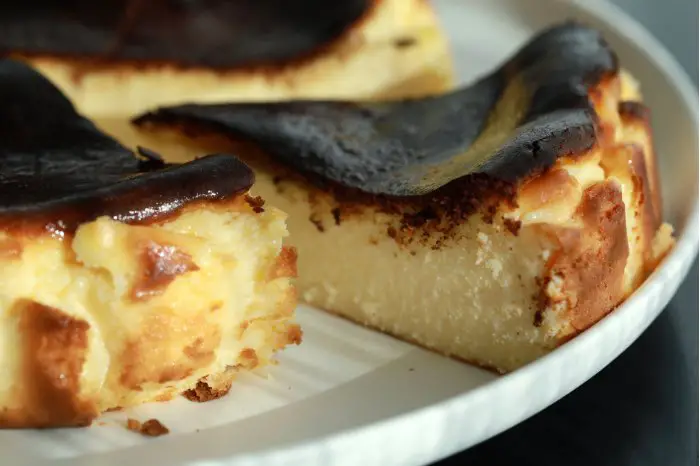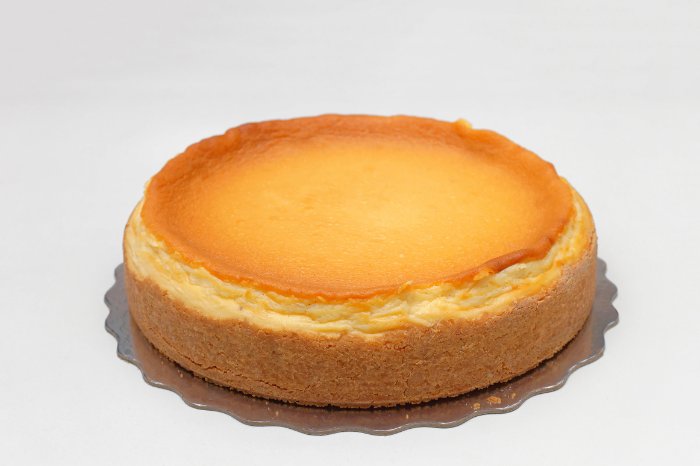Last Updated on January 26, 2023
Why does my cheesecake have a weird texture? Before anything else, it is typical for beginners to make minor mistakes that can throw everything off. Regardless of that, please do not be afraid to make mistakes.
Essentially, cheesecakes are undoubtedly one of the most delectable desserts you can make at home. And everyone in your household will look forward to your cheesecakes. The main reason is that it is irresistible.
Along the way, you will ask questions like why is my cheesecake grainy? Why is my cheesecake texture not smooth?
Also, what texture should a baked cheesecake be? Why did my cheesecake turn out rubbery?
To find the answers to the questions, make sure to keep reading. And by the time you know why each of them happens, it should be a piece of cake to prevent making these specific mistakes ever again.
Why Does My Cheesecake Have A Weird Texture?
Whenever you have a cheesecake that does not taste how you wanted it to be, the primary reason could be the eggs; keep in mind that the eggs become grainy due to the proteins contracting. And as a result, it forces the moisture out, especially when they overcook.
Additionally, you will often observe liquid seeping out of your cheesecake when this typically occurs. That is why your cheesecake tends to crack whenever you have overcooked it.
So why is my cheesecake grainy? Before answering this, it is vital to know that you usually make baked and non-baked cheesecakes in various methods. In this regard, there are different reasons why you end up with an undesired grainy texture.

Baked Cheesecakes – Why Does My Cheesecake Have A Weird Texture?
For the most part, your baked cheesecake can end up with a grainy texture. However, how it could happen is slightly different compared to non-baked cheesecakes.
Generally, manufacturers calibrate conventional ovens differently. That is why few ovens heat up quicker or fluctuate between different temperatures. Because of this, it could significantly impact your cheesecake’s baking time.
Additionally, a fan-based oven usually bakes food quicker compared to conventional ovens. Because of this, it may, unfortunately, lead to unexpected disasters for any recipe that requires steady and slow baking, especially your baked cheesecake.
But do not worry at all if you have a fan-based oven because you can always try lessening the temperature by 20 degrees Celsius or 50 degrees Fahrenheit. Likewise, you may utilize an oven thermometer to measure the heat levels when creating cheesecake. With this, you can also modify the baking time, including the temperature accordingly.
Another way to avoid overcooking the eggs is to monitor your cheesecake and know how to spot an adequately baked dessert. Remember, by not letting your cheesecake bake more than it should; you will lessen the chance of the eggs overcooking.
Overcooking The Eggs
Most of the time, a grainy baked cheesecake is usually a clear sign that you have accidentally overcooked the eggs; keep in mind that baked cheesecakes have eggs. Unless, of course, you baked it the vegan way. Bear in mind that the eggs are the ones responsible for giving structure. Not only that but also it allows your cheesecake batter to bind well.
The problem typically happens when you have cooked your cheesecake for longer or at a higher temperature than what should be in the recipe. Consequently, it will cause the eggs to overcook, and even worse, it will make your cheesecake grainy. The reason is that the proteins in the cheesecake will force the moisture to seep out. And as a result, it will lead to cracks in the crust. Not only that but also a bit of liquid will start oozing out.
No-bake Cheesecakes
Whenever making these kinds of cheesecakes, you must utilize the appropriate ingredients. In addition to that, ensure to mix them adequately. The main reason is that mixing affects the sugar in the cheesecake batter.
Also, keep in mind that one of the most typical reasons a no-bake cheesecake can turn grainy is due to incorrect mixing; as a consequence, the sugar will not dissolve properly.
For instance, if you did not cream the granulated sugar well, there is no doubt that you will have small chunks of undissolved sugar in the filling. As a result, it can indeed make the dessert’s texture grainy.
Additionally, mix all your ingredients properly. Doing so ensures that the sugar dissolves completely. Please note that many professional bakers suggest that using a food processor is a brilliant idea. However, be careful since overmixing the ingredients will result in an incredibly soft filling that does not maintain its shape, regardless of whether you stored it in the refrigerator for several hours.
On the contrary, utilizing a spatula or whisk does not cream the cheese and sugar well enough to achieve a smooth texture. That is why, if you are still using old-fashioned elbow grease, it would be best if you bought a cheesecake mixer.
Click Here to Get Info About:
- Delicious Cheesecake Recipe With Condensed Milk: Quick & Easy
- Easy Decadent 15 Minute Chocolate Glaze For Cheesecake
Not Using Room-temped Cream Cheese
Another explanation for why your cream cheese has a weird texture is not using room-temperature cream cheese. In this regard, be sure that the cream cheese is at room temperature; keep in mind that doing so, will help the sugar mix to cheese, including the other ingredients.
Also, if your cream cheese is exceedingly cold, the sugar may not dissolve well, making the cheesecake grainy and crumbly.
Remember, this room temperature rule applies to all your ingredients since bear in mind that they will not blend as effortlessly with the creamed sugar and cheese if they are not at room temperature.
Mueller Ultra-Stick 500 Watt 9-Speed Immersion Multi-Purpose Hand Blender
Not Using Refined Sugar – Why Does My Cheesecake Have A Weird Texture?
Please note that fine-ground sugar tends to dissolve and melt quicker than granules.
Also, in most cases, your granulated sugar might be incredibly thick. In addition to that, it would be challenging to combine the other ingredients when using granulated sugar.
To fix that particular problem, you may use a suitable ground substitute like caster sugar; keep in mind that this type of sugar dissolves way better. Not only that, but also it mixes well with your cream cheese.
Because of that, there is no denying that you will produce a non-grainy texture when you remove the dessert from your refrigerator.
Take Out Time to Also Read:
Tips And Tricks: Why Does My Cheesecake Have A Weird Texture?
First and foremost, why is my cheesecake texture not smooth? In most cases, the overbaked cheesecake will lead to unpleasing cracks. Not only that, but also it will have a crumbly and dry surface. Often, when your cheesecake is ready, it will not be firm since cheesecake is custard.
In that regard, the most effective method to ensure that you do not overbake the cheesecake is to give it a little jiggle. Afterward, take your wooden spoon. After that, tap the cake pan on the side. By doing this, the cheesecake should jiggle a bit in the middle if it is ready. Remember, it requires more time to bake if you notice the cheesecake jiggles and ripples.
So, what texture should a baked cheesecake be? Well, as opposed to the unappealing, crumbly, and dry surface of an overbaked cheesecake, a perfectly-baked cheesecake’s surface is undoubtedly smooth and rich. To achieve such an excellent texture, make sure to keep a steady and low oven temperature.

Moreover, why did my cheesecake turn out rubbery? Well, for the most part, the custard can take on a rubbery texture without the moist heat of a water bath; keep in mind that cheesecakes are essentially a rich custard that is why you need to treat it cautiously. Also, you have to remember that your main goal is to bake your cheesecake evenly and slowly without ever browning its top.
Please be aware that a water bath or bain-marie is a pan of hot water that protects your delicate cheesecakes while baking in your conventional oven.
FAQ’s
Why Is My Cheesecake Grainy?
There are plenty of reasons your cheesecake becomes grainy; it could be overcooking the eggs and having a fan-based oven for baked cheesecakes. At the same time, it might be not using refined sugar, improper mixing, and not using room-temped cream cheese for no-bake cheesecakes.
Why Is My Cheesecake Texture Not Smooth?
The main reason is that you have overbaked your cheesecake; keep in mind that an overbaked cheesecake will result in unsightly cracks, not to mention a dry and crumbly surface.
What Texture Should A Baked Cheesecake Be?
Always remember that a perfectly-baked cheesecake possesses a rich and smooth texture. That is why it is best to maintain a low and steady conventional oven temperature.
Why Did My Cheesecake Turn Out Rubbery?
The reason is that you did not do a water bath; bear in mind that without the water bath's moist heat, the custard will result in a rubbery texture. So with this, it is best to bake your cheesecakes slowly and evenly as possible without ever browning the cheesecake's top.

Zarah is an experienced pastry chef whose creations have delighted countless customers. With a passion for baking, Zarah has developed a unique style that combines classic techniques with modern flavors. Her desserts are consistently crafted with the finest ingredients, and her attention to detail is evident in the stunning and delectable results. Zarah has a wealth of experience in the pastry kitchen, and loves to share her knowledge with others. Whether it is teaching a class or creating a custom cake for a special occasion, Zarah is committed to making sure every customer is satisfied.


